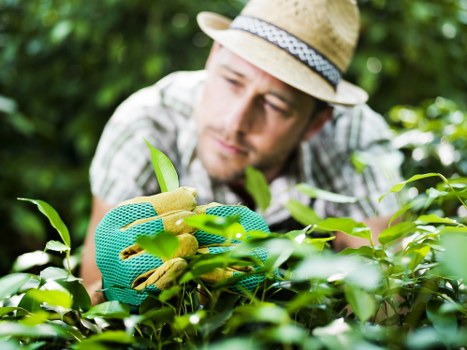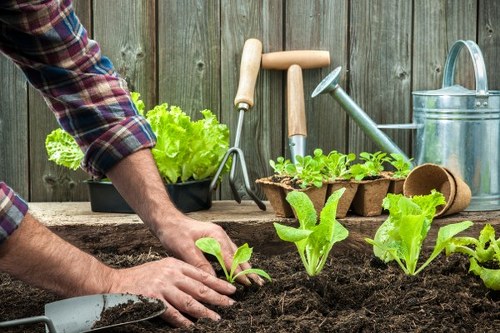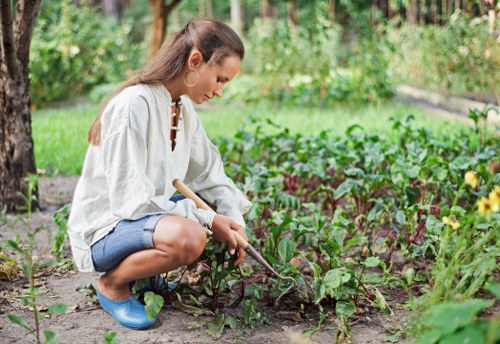Landscape Gardening in Cleaners EC2
Benefits of Landscape Gardening

Landscape gardening offers numerous advantages for residents of Cleaners EC2, enhancing both the aesthetic appeal and functionality of outdoor spaces. By thoughtfully designing and maintaining a garden, homeowners can create a serene environment that promotes relaxation and well-being.
One of the primary benefits is the increase in property value. A well-maintained garden can significantly boost the curb appeal of a home, making it more attractive to potential buyers. Additionally, landscape gardening can contribute to environmental sustainability by promoting biodiversity and reducing carbon footprints.
Moreover, a beautifully landscaped garden provides a perfect setting for outdoor activities and social gatherings. Whether it's a family barbecue, a quiet evening under the stars, or a weekend gardening project, having a dedicated outdoor space enhances the quality of life.
Selecting the Right Plants for Cleaners EC2

Choosing the appropriate plants is crucial for the success of any landscape garden in Cleaners EC2. The local climate, soil conditions, and maintenance capabilities should all be considered when selecting plant species. Opting for native plants can be particularly beneficial, as they are well-adapted to the local environment and require less maintenance.
It's also important to consider the aesthetic aspects, such as color, texture, and height, to create a harmonious and visually appealing garden. Incorporating a variety of plants, including trees, shrubs, perennials, and annuals, can add depth and interest to the landscape.
Additionally, considering the seasonal changes and selecting plants that bloom at different times can ensure that the garden remains vibrant throughout the year. This diversity not only enhances the beauty of the garden but also supports local wildlife, including pollinators like bees and butterflies.
Designing Your Garden Layout

A well-thought-out garden layout is essential for maximizing the use of space and creating a functional outdoor area. Start by assessing the available space and determining the purpose of the garden, whether it's for relaxation, entertainment, or growing vegetables.
Incorporate elements such as pathways, seating areas, water features, and lighting to enhance the functionality and appeal of the garden. Pathways can guide visitors through the garden, while seating areas provide spots for rest and socializing.
Water features, such as fountains or ponds, add a soothing sound and attract wildlife, creating a tranquil atmosphere. Proper lighting not only highlights the garden’s features but also extends its usability into the evening hours.
Sustainable Gardening Practices

Adopting sustainable gardening practices is essential for minimizing environmental impact and promoting a healthy ecosystem in Cleaners EC2. Implementing water-efficient techniques, such as drip irrigation and rainwater harvesting, can significantly reduce water consumption.
Using organic fertilizers and compost helps maintain soil health without the harmful effects of chemical pesticides and fertilizers. Composting kitchen and garden waste not only enriches the soil but also reduces landfill contributions.
Furthermore, integrating native and drought-resistant plants reduces the need for excessive watering and maintenance, making the garden more resilient to climate variations and reducing overall resource usage.
Maintenance Tips for a Thriving Garden

Regular maintenance is key to ensuring that a landscape garden in Cleaners EC2 remains healthy and beautiful throughout the year. This includes routine tasks such as watering, weeding, pruning, and fertilizing.
Establishing a maintenance schedule can help manage these tasks effectively. Monitoring plant health and addressing any issues promptly, such as pest infestations or diseases, is crucial for preventing larger problems.
Additionally, mulching around plants can help retain soil moisture, regulate temperature, and suppress weed growth, contributing to a more sustainable and low-maintenance garden.
Choosing the Right Tools and Equipment
Having the right tools and equipment makes garden maintenance more efficient and enjoyable. Essential tools include a good quality shovel, pruners, a watering can or hose, and gardening gloves.
Investing in high-quality tools ensures durability and ease of use, which can make a significant difference in the overall gardening experience. Additionally, using eco-friendly products and equipment aligns with sustainable gardening practices, reducing the environmental footprint of your garden.
- Shovel
- Pruners
- Watering can or hose
- Gardening gloves
- Mulch
Integrating Hardscaping Elements
Incorporating hardscaping elements, such as patios, decks, and pathways, complements the natural beauty of the garden while adding structure and functionality. Materials like stone, wood, and brick can be used to create durable and aesthetically pleasing features.
Hardscaping provides practical benefits, such as defined spaces for seating and dining, and helps in managing garden layout by separating different areas for various activities.
- Patios for outdoor dining
- Decks for relaxation
- Stone pathways for navigation
- Retaining walls for landscape management
- Water features for visual interest
Enhancing Garden with Lighting
Proper lighting can transform a garden, highlighting its features and extending its usability into the night. Solar-powered lights are an eco-friendly option that reduces energy consumption while providing adequate illumination.
Pathway lights ensure safe navigation, while spotlights can accentuate trees, statues, or water features, adding depth and dimension to the garden’s nighttime appearance.
String lights or lanterns create a warm and inviting ambiance, perfect for evening gatherings and adding a magical touch to the outdoor space.
Creating a Wildlife-Friendly Garden
Designing a garden that attracts and supports local wildlife enhances the biodiversity and ecological balance. Planting a variety of flowers and shrubs provides food and shelter for pollinators, birds, and beneficial insects.
Installing bird feeders, birdhouses, and insect hotels encourages wildlife to inhabit the garden, adding life and movement to the outdoor space.
Moreover, creating a water source, such as a birdbath or small pond, supports the needs of various species, promoting a thriving and dynamic garden ecosystem.
Seasonal Gardening Tips

Adapting gardening practices to the changing seasons ensures that the garden remains vibrant and healthy throughout the year. In spring, focus on planting new growth and preparing the soil for the growing season.
Summer requires diligent watering and pest control to maintain plant health during the heat. Fall is ideal for planting bulbs and preparing the garden for winter by mulching and pruning.
During winter, protect sensitive plants from frost and take the time to plan for the upcoming gardening year, ensuring a smooth transition once the growing season begins again.
Choosing Professional Landscaping Services
For those who prefer professional assistance, hiring a reputable landscaping service in Cleaners EC2 can make a significant difference in achieving the desired garden. Professional landscapers bring expertise and experience, ensuring that the garden is designed and maintained to the highest standards.
They can provide tailored solutions based on individual needs, preferences, and budget, offering services such as garden design, installation, maintenance, and seasonal planting.
Moreover, professional services can help navigate local regulations and environmental considerations, ensuring that the garden is both beautiful and compliant with local guidelines.
Incorporating Sustainable Materials
Using sustainable materials in garden design minimizes environmental impact and promotes long-term viability. Recycled materials, such as reclaimed wood and recycled metal, can be used for structures like fences, trellises, and garden furniture.
Natural stone and locally sourced materials reduce the carbon footprint associated with transportation and manufacturing, supporting local economies and reducing waste.
Additionally, choosing durable and low-maintenance materials ensures that the garden remains functional and attractive with minimal upkeep, contributing to a sustainable and eco-friendly landscape.
Creating Privacy in Your Garden
Privacy is a key consideration for many homeowners when designing their garden. Strategic placement of plants, trees, and structures can create secluded and intimate spaces within the garden.
Hedges, tall shrubs, and evergreen trees provide natural barriers that shield the garden from neighbors and passersby, ensuring a sense of seclusion and tranquility.
Incorporating elements like pergolas, fences, and screens can further enhance privacy while adding to the garden's aesthetic appeal.
Utilizing Vertical Gardening Techniques
Vertical gardening is an effective way to maximize space, especially in smaller gardens. By growing plants vertically on structures like trellises, walls, and towers, gardeners can increase plant diversity without taking up valuable ground space.
This technique is particularly useful for climbing plants, such as vines and flowering climbers, which can add vertical interest and beauty to the landscape.
- Trellises and arbors
- Living walls
- Vertical planters
- Hanging baskets
- Stacked containers
Implementing Irrigation Systems
Efficient irrigation systems are essential for maintaining a healthy garden, especially during dry spells. Drip irrigation and soaker hoses deliver water directly to the plant roots, minimizing evaporation and water waste.
Automated irrigation systems can be programmed to water at optimal times, ensuring consistent moisture levels without manual intervention.
Proper irrigation not only conserves water but also promotes robust plant growth, reducing the risk of drought stress and improving overall garden health.
Using Mulch for Soil Health
Mulching is a fundamental gardening practice that offers several benefits, including moisture retention, temperature regulation, and weed suppression. Organic mulches, such as bark, straw, and compost, enrich the soil as they decompose.
Applying a layer of mulch around plants helps maintain consistent moisture levels, reducing the need for frequent watering and promoting healthier root systems.
Additionally, mulch acts as a barrier against weed growth, reducing competition for nutrients and making garden maintenance easier.
Creating Focal Points in the Garden
Focal points draw attention and provide a visual anchor within the garden, enhancing its overall design and appeal. Common focal points include statues, water features, specimen plants, and garden art.
Choosing a striking element as a focal point can define the garden's style and guide the eye through the landscape, creating a sense of balance and harmony.
Rotating or changing focal points seasonally can keep the garden dynamic and interesting, offering new perspectives and experiences throughout the year.
Maintaining Garden Health

Ensuring the health of your garden involves regular monitoring and proactive care. Inspect plants regularly for signs of pests, diseases, and nutrient deficiencies, addressing issues promptly to prevent widespread damage.
Proper pruning techniques help maintain plant shape, remove dead or diseased branches, and encourage healthy growth. It's important to prune at the right times of the year to avoid stressing the plants.
Soil health plays a crucial role in garden vitality. Regularly testing soil pH and nutrient levels allows gardeners to amend the soil as needed, providing the optimal environment for plant growth.
Enhancing Garden Aesthetics with Color
Color plays a significant role in garden design, influencing mood and visual appeal. Selecting a color scheme that complements the surroundings and personal preferences can create a cohesive and harmonious garden.
Incorporating a mix of vibrant and subdued hues adds depth and interest, while monochromatic schemes provide a sleek and modern look. Seasonal color changes also keep the garden lively and engaging throughout the year.
Using colorful plants, flowers, accessories, and materials can enhance the overall aesthetic, making the garden a beautiful and inviting space.
Seasonal Landscaping Projects
Engaging in seasonal landscaping projects keeps the garden fresh and adaptive to changing conditions. In spring, focus on planting new blooms and preparing beds for the growing season.
Summer projects may include installing shade structures, adding vibrant annuals, and maintaining irrigation systems to cope with the heat. In autumn, plant bulbs for spring, clear fallen leaves, and prepare plants for winter.
Winter landscaping involves protecting delicate plants from frost, pruning trees, and planning for the next gardening cycle, ensuring that the garden remains resilient and ready for renewal.
Incorporating Edible Plants
Integrating edible plants into the landscape garden not only adds beauty but also provides fresh produce for personal use. Herbs, vegetables, and fruit-bearing plants can be creatively incorporated into the garden design.
Raised beds, vertical planters, and dedicated vegetable patches optimize space and make harvesting easier. Companion planting techniques can enhance growth and deter pests naturally.
Edible gardens promote sustainability and self-sufficiency, allowing homeowners to enjoy the fruits of their labor while contributing to a healthy lifestyle.
Creating Pathways and Borders
Pathways guide movement through the garden and connect different areas, while borders define spaces and add structure. Materials such as gravel, stone, brick, and wood can be used to create durable and attractive paths and borders.
Curved pathways add a sense of exploration and discovery, while straight paths offer a more formal and structured appearance. Borders can be used to contain planting beds, garden art, or seating areas, enhancing the overall design.
- Gravel pathways for a natural look
- Stone borders for elegance
- Brick paths for durability
- Wooden walkways for rustic charm
- Decorative edging for defined spaces
Using Garden Art and Decor
Incorporating art and decor into the garden adds personality and enhances visual interest. Sculptures, wind chimes, garden stakes, and decorative pots can personalize the outdoor space.
Choosing pieces that complement the garden’s theme and color scheme creates a cohesive and aesthetically pleasing environment. Rotating or changing decorative elements seasonally can keep the garden dynamic and engaging.
Additionally, incorporating functional art, such as benches, trellises, and arbors, combines beauty with utility, making the garden both attractive and practical.
Maintaining Healthy Soil
Healthy soil is the foundation of a thriving garden. Regularly enriching the soil with organic matter, such as compost and manure, improves its structure, fertility, and water retention capabilities.
Implementing crop rotation and cover cropping techniques prevents soil depletion and reduces the risk of pest and disease buildup.
Testing soil regularly for pH and nutrient levels allows for precise amendments, ensuring that plants receive the necessary nutrients for optimal growth.
Creating a Garden Schedule
Establishing a garden schedule helps manage tasks effectively, ensuring that all aspects of garden care are addressed timely. A seasonal calendar outlining planting, pruning, watering, and harvesting tasks keeps the garden on track.
Using gardening apps or planners can assist in organizing tasks and setting reminders, making it easier to maintain consistency and efficiency in garden maintenance.
A well-maintained schedule promotes a healthy and vibrant garden, preventing neglect and ensuring that each plant receives the attention it needs throughout the year.
Integrating Technology in Gardening
Modern technology offers various tools and innovations that enhance gardening efficiency and enjoyment. Smart irrigation systems, automated lighting, and garden monitoring sensors simplify maintenance and optimize resource usage.
Gardening apps provide information on plant care, weather forecasts, and pest identification, making it easier for gardeners to manage their gardens effectively.
Additionally, online platforms and communities offer support, inspiration, and the opportunity to share experiences, fostering a sense of community among garden enthusiasts in Cleaners EC2.
Creating Outdoor Living Spaces
Outdoor living spaces extend the functionality of the garden, providing areas for relaxation, entertainment, and enjoyment of nature. Designing spaces with comfortable seating, dining areas, and sheltered zones enhances the usability of the garden.
Incorporating features such as fire pits, outdoor kitchens, and entertainment systems creates a versatile and inviting environment for gatherings and personal relaxation.
Thoughtful design ensures that these spaces blend seamlessly with the natural elements of the garden, creating a harmonious and integrated outdoor living area.
Conclusion: Transform Your Outdoor Space
Landscape gardening in Cleaners EC2 offers a myriad of opportunities to enhance your outdoor space, making it a beautiful, functional, and sustainable extension of your home. By carefully selecting plants, designing thoughtful layouts, and adopting sustainable practices, you can create a garden that reflects your personal style and meets your lifestyle needs.
Whether you choose to embark on this journey yourself or enlist the help of professional landscapers, the rewards of a well-maintained garden are well worth the effort. Embrace the beauty and tranquility that landscape gardening brings, and transform your outdoor area into a haven of relaxation and enjoyment.
Contact us today to start your landscape gardening project and bring your dream garden to life in Cleaners EC2.


